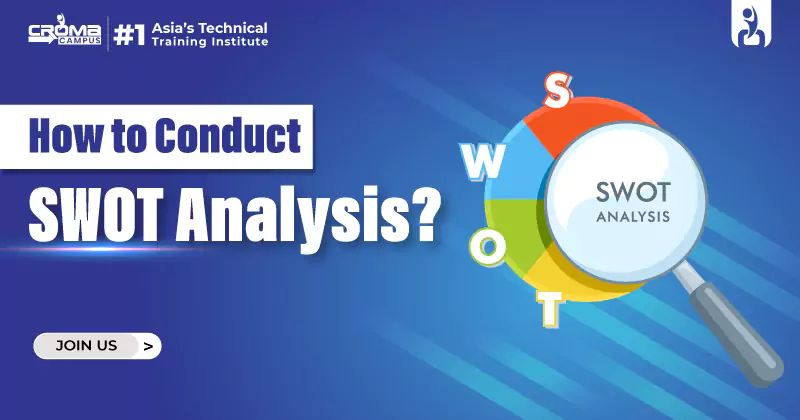How To Conduct SWOT Analysis?
4.8 out of 5 based on 8566 votesLast updated on 13th Jul 2024 16.37K Views
- Bookmark

SWOT Analysis is a strategic tool that evaluates an organization's Strengths, Weaknesses, Opportunities, and Threats to inform decision-making and planning.

Introduction
A SWOT analysis is a foundational tool in strategic management, providing organizations with a structured framework to assess their current position and future prospects. By evaluating internal strengths and weaknesses alongside external opportunities and threats, businesses gain valuable insights into areas where they excel, challenges they face, and opportunities they can leverage. This systematic approach not only enhances decision-making but also facilitates proactive planning and risk management. Aspiring professionals must consider getting the BA Certification to expand their opportunities in the market.
In an increasingly competitive global economy, understanding these critical factors through SWOT analysis enables companies to align their resources effectively, capitalize on market trends, and navigate uncertainties with greater confidence.
What Is SWOT Analysis?
SWOT analysis is a strategic planning tool used to assess the internal strengths and weaknesses of a business, project, or individual, as well as the external opportunities and threats it faces in the market or industry. The acronym SWOT stands for Strengths, Weaknesses, Opportunities, and Threats, which are systematically evaluated to provide a comprehensive understanding of the current situation and potential future directions.
Strengths typically encompass internal capabilities or advantages that give an entity a competitive edge, such as unique skills, resources, or market position. Weaknesses, on the other hand, involve internal limitations or vulnerabilities that may hinder performance, such as lack of resources, skills gaps, or operational inefficiencies.
Opportunities refer to external factors or trends in the environment that can be leveraged to achieve strategic goals, such as emerging markets, technological advancements, or changing consumer preferences. Threats, meanwhile, are external factors that may pose risks or challenges to the entity's success, such as intense competition, economic downturns, or regulatory changes.
By conducting a SWOT analysis, organizations can identify key areas for improvement, capitalize on opportunities, mitigate risks, and formulate strategies that align with their objectives. This structured assessment enables informed decision-making, proactive planning, and adaptation to changing market conditions, ultimately enhancing competitiveness and sustainability in the marketplace.
How To Conduct A SWOT Analysis?
Conducting a SWOT analysis involves a systematic assessment of an organization, project, or individual's strengths, weaknesses, opportunities, and threats. Check the Business Analyst Certification Cost can invest in a training program for the best guidance.
Here's a detailed guide to conducting a SWOT analysis, broken down into each component:
1. Strengths
Definition: Identify internal attributes and resources that provide a competitive advantage or positive impact.
Process:
- Brainstorming: Gather input from stakeholders, employees, and data sources to list strengths.
- Evaluation: Assess each strength based on relevance, uniqueness, and impact on objectives.
Examples: Strong brand reputation, skilled workforce, proprietary technology.
2. Weaknesses
Definition: Internal factors that hinder progress or put at a disadvantage.
Process:
- Identification: Recognize areas where resources are lacking, processes are inefficient, or skills are inadequate.
- Evaluation: Rank weaknesses by severity and their impact on goals.
Examples: High employee turnover, outdated technology infrastructure, limited market presence.
3. Opportunities
Definition: External factors that could be exploited to advance goals or create new advantages.
Process:
- Environmental Scan: Analyse market trends, economic conditions, regulatory changes, and technological advancements.
- Identification: List potential avenues for growth, partnership opportunities, or emerging markets.
Examples: Growing market demand for a specific product, favourable regulatory changes, and new partnership prospects.
4. Threats
Definition: External elements that could jeopardize objectives or harm the organization.
Process:
- Research: Investigate competitive landscape, economic risks, technological threats, and market dynamics.
- Identification: List potential obstacles, risks of substitute products/services, or regulatory challenges.
Examples: Intense competition, economic downturns, changing consumer preferences, legal and regulatory uncertainties.
for Conducting a SWOT Analysis:
- Cross-functional Collaboration: Involve diverse perspectives from various departments or stakeholders to ensure comprehensive insights.
- Realism and Specificity: Avoid vague or overly broad statements. Use concrete examples and data where possible.
- Focus on Relevance: Prioritize factors that directly impact strategic objectives and goals.
- Continuous Review: Update the SWOT analysis regularly to reflect changes in the internal and external environment. Consider investing in the BA Certification to learn more about these techniques.
Example of SWOT Analysis Application:
- Scenario: A tech startup specializing in AI-driven customer service chatbots.
- Strengths: Advanced AI algorithms, experienced development team, strong investor backing.
- Weaknesses: High initial costs, limited brand recognition, dependency on a few key technologies.
- Opportunities: Growing demand for AI in customer service, expansion into new markets, and potential strategic partnerships.
- Threats: Intense competition from established tech giants, rapid technological obsolescence, and regulatory challenges in data privacy.
Importance Of SWOT Analysis
SWOT analysis holds significant importance in strategic management and decision-making processes for several key reasons:
1. Strategic Planning Tool:
SWOT analysis provides a structured framework for organizations to assess both internal capabilities and external market conditions. It helps in identifying where the organization stands currently and where it could potentially go in the future by leveraging strengths and opportunities while mitigating weaknesses and threats.
2. Enhanced Decision-Making:
By systematically evaluating strengths, weaknesses, opportunities, and threats, SWOT analysis enables informed decision-making. It helps prioritize initiatives based on their alignment with organizational strengths and market opportunities, while also addressing weaknesses and threats that could impact performance.
3. Competitive Advantage:
Understanding internal strengths and external opportunities allows organizations to capitalize on their unique advantages in the marketplace. By identifying and leveraging strengths effectively, businesses can differentiate themselves from competitors and enhance their market position.
4. Risk Management:
SWOT analysis aids in identifying potential threats and vulnerabilities that could affect business operations. By anticipating and assessing external threats such as market shifts, competitive pressures, or regulatory changes, organizations can develop contingency plans and proactive strategies to mitigate risks.
5. Resource Allocation:
Through SWOT analysis, organizations can allocate resources more effectively. By focusing on areas where strengths can be maximized and weaknesses addressed, businesses optimize resource utilization and enhance operational efficiency.
6. Business Growth and Innovation:
SWOT analysis helps identify new opportunities for growth and innovation. By exploring emerging market trends, technological advancements, or consumer preferences, organizations can develop strategic initiatives that drive growth and expand market reach.
7. Continuous Improvement:
SWOT analysis is an iterative process that encourages continuous improvement. Regularly revisiting and updating the analysis allows organizations to adapt to changing market dynamics, refine strategies, and stay responsive to evolving customer needs and competitive pressures.
Conclusion
In summary, conducting a SWOT analysis serves as a vital tool in strategic planning, offering businesses a clear understanding of their internal strengths and weaknesses, as well as external opportunities and threats. By systematically evaluating these factors, organizations can make informed decisions, capitalize on strengths, address weaknesses, seize opportunities for growth, and proactively manage potential threats. Aspiring Business Analysts can check the Business Analyst Certification Cost and join a training program for the best guidance. The iterative nature of SWOT analysis ensures its relevance in adapting to changing market dynamics and guiding effective strategies that align with business goals. Ultimately, embracing SWOT analysis fosters resilience, innovation, and competitive advantage in today's dynamic business landscape.
Subscribe For Free Demo
Free Demo for Corporate & Online Trainings.
Your email address will not be published. Required fields are marked *









.jpg)











 Master in Cloud Computing Training
Master in Cloud Computing Training